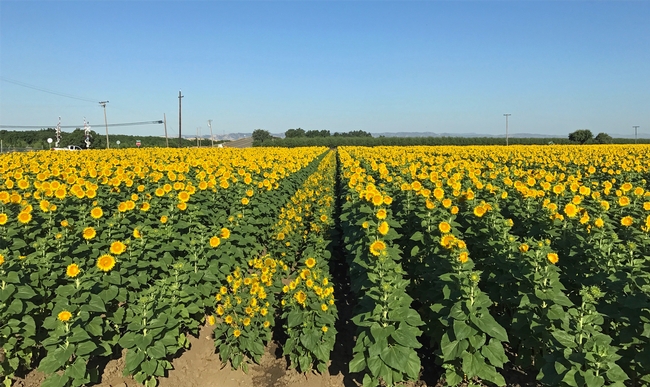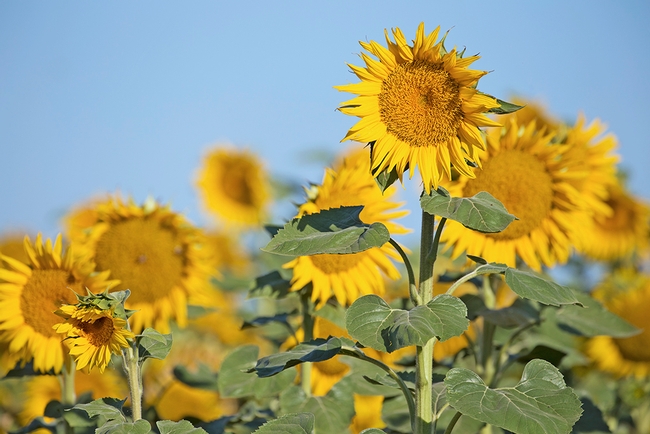Radiant daisy-like sunflowers produce a valuable crop with little water
Sweeping acres of striking golden flowers may soon grace California's desert southwest. UC Cooperative Extension irrigation specialist Khaled Bali believes sunflowers may be an ideal crop for the state's most punishing agricultural region.
California produces more than 90 percent of the country's hybrid sunflower planting seed, which is shipped around the nation and world. The seed is used to grow sunflower seeds for a healthy snack or salad topper, and for seeds that are expressed into sunflower oil, valued for its clean taste and polyunsaturated fat.
Most California seed is produced on about 50,000 acres in the Sacramento Valley. But the plant's low water use and early maturity hold promise for production in Southern California's low desert.
Bali's research began two years ago with 1,800 plots of sunflowers, nearly 300 different genotypes, at the UC Desert Research and Extension Center in Holtville. All plants were well-watered for four weeks before drought treatment started. In 2016, the trial plots were irrigated at 60 percent of the area's ETo (the full amount of water used by well-irrigated, mowed grass in that environment), and at 100 percent.
“Sunflower is a California native species grown as a hybrid seed crop,” Bali said. “With limited water, we wanted to look at varieties that tolerate drought and stress.”
That year, Bali found significant variation in yield across the varieties, but no difference between plots that received 60 percent of ETo and 100 percent
“I've been doing deficit irrigation for a long time,” Bali said. “I never expected that.”
For the 2017 season, the 60 percent ETo plots were dropped to 10 percent to better understand the implications of severe drought on the sunflower cultivars.
“The emphasis in 2017 was to intensify our drought treatment, giving less water earlier and to quantify the genotypes' drought avoidance strategy by digging up roots and using computer image analysis to determine root traits,” Bali said.
Bali attributes the sunflower crop's low water needs to its deep tap root and crop production timing. Sunflower in the low desert may be planted from January to February, and harvested in May and June.
“Sunflower water needs are relatively low since they are harvested before the hottest part of the summer,” Bali said.
His research is continuing in 2018.
A new UC publication, Sunflower Hybrid Seed Production in California, is now under review and is expected to be available to producers in fall 2018. Written by UC Cooperative Extension advisor Rachael Long and colleagues, including Bali, the publication outlines crop production standards, land preparation, fertilization, pest management, harvesting and more.
Long said sunflowers are favored for crop rotations because they help in long-term management of weeds and diseases, the plants add biomass to the soil after harvest, and they are a profitable specialty field crop.
Read more about California sunflowers in a Green Blog post by Rachael Long, Sunflower seeds are boosting California's ag economy.
Comments:
You



Posted by Mike on July 7, 2021 at 10:34 PM